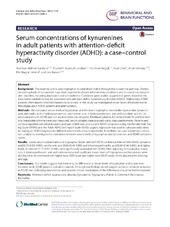| dc.contributor.author | Hegvik, Tor-Arne | en_US |
| dc.contributor.author | Ulvik, Arve | en_US |
| dc.contributor.author | Halmøy, Anne | en_US |
| dc.contributor.author | Haavik, Jan | en_US |
| dc.contributor.author | Aarsland, Tore Ivar Malmei | en_US |
| dc.contributor.author | Landaas, Elisabeth Toverud | en_US |
| dc.contributor.author | Ueland, Per Magne | en_US |
| dc.date.accessioned | 2016-10-05T07:58:59Z | |
| dc.date.available | 2016-10-05T07:58:59Z | |
| dc.date.issued | 2015-11-05 | |
| dc.Published | Behavioral and Brain Functions 2015, 11(1):36 | eng |
| dc.identifier.uri | https://hdl.handle.net/1956/12921 | |
| dc.description.abstract | Background: The essential amino acid tryptophan is catabolised mainly through the kynurenine pathway. Altered circulating levels of kynurenines have been reported in chronic inflammatory conditions and in several neuropsychiatric disorders, including depression and schizophrenia. Candidate gene studies suggest that genes related to the kynurenine catabolism may be associated with attention-deficit hyperactivity disorder (ADHD). Additionally, ADHD patients often report comorbid depression or anxiety. In this study we investigated serum levels of kynurenines in Norwegian adult ADHD patients and adult controls. Methods: We compared serum levels of tryptophan and the seven tryptophan metabolites kynurenine, kynurenic acid, anthranilic acid, 3-hydroxykynurenine, xanthurenic acid, 3-hydroxyanthranilic acid and quinolinic acid in 133 adult patients with ADHD and 131 adult controls (18–40 years). Riboflavin (vitamin B2), total vitamin B6 and the nicotine metabolite cotinine were also measured. Serum samples were analysed using mass spectrometry. Patients and controls reported comorbid disorders and past (childhood) and current ADHD symptoms using the Wender Utah Rating Scale (WURS) and the Adult ADHD Self-report Scale (ASRS). Logistic regression was used to calculate odds ratios for having an ADHD diagnosis for different serum levels of each metabolite. In addition, we used Spearman’s correlation analysis to investigate the correlation between serum levels of tryptophan and kynurenines and ADHD symptom scores. Results: Lower serum concentrations of tryptophan [odds ratio 0.61 (95 % confidence interval 0.45–0.83)], kynurenic acid [0.73 (0.53–0.99)], xanthurenic acid [0.65 (0.48–0.89)] and 3-hydroxyanthranilic acid [0.63 (0.46–0.85)], and higher levels of cotinine [7.17 (4.37–12.58)], were significantly associated with ADHD. After adjusting for tryptophan levels, only 3-hydroxyanthranilic acid and cotinine remained significant. Lower levels of tryptophan and kynurenine were also found to be correlated with higher total ASRS score and higher total WURS score, when adjusting for smoking and age. Conclusions: Our results suggest that there may be differences in serum levels of tryptophan and kynurenines between adult ADHD patients and adult controls. Although our findings do not suggest a chronic immune activation in ADHD, the underlying mechanisms and possible clinical implications of the differences should be further explored. | en_US |
| dc.language.iso | eng | eng |
| dc.publisher | BioMed Central | eng |
| dc.rights | Attribution CC BY | eng |
| dc.rights.uri | https://creativecommons.org/licenses/by/4.0/ | eng |
| dc.subject | Attention-deficit hyperactivity disorder | eng |
| dc.subject | Kynurenine | eng |
| dc.subject | Tryptophan | eng |
| dc.subject | Vitamin B | eng |
| dc.subject | Cotinine | eng |
| dc.subject | Inflammation | eng |
| dc.subject | Biomarker | eng |
| dc.title | Serum concentrations of kynurenines in adult patients with attention-deficit hyperactivity disorder (ADHD): a case–control study | en_US |
| dc.type | Peer reviewed | |
| dc.type | Journal article | |
| dc.date.updated | 2016-02-25T14:34:13Z | |
| dc.description.version | publishedVersion | en_US |
| dc.rights.holder | Aarsland et al. | |
| dc.identifier.doi | https://doi.org/10.1186/s12993-015-0080-x | |
| dc.identifier.cristin | 1303677 | |

